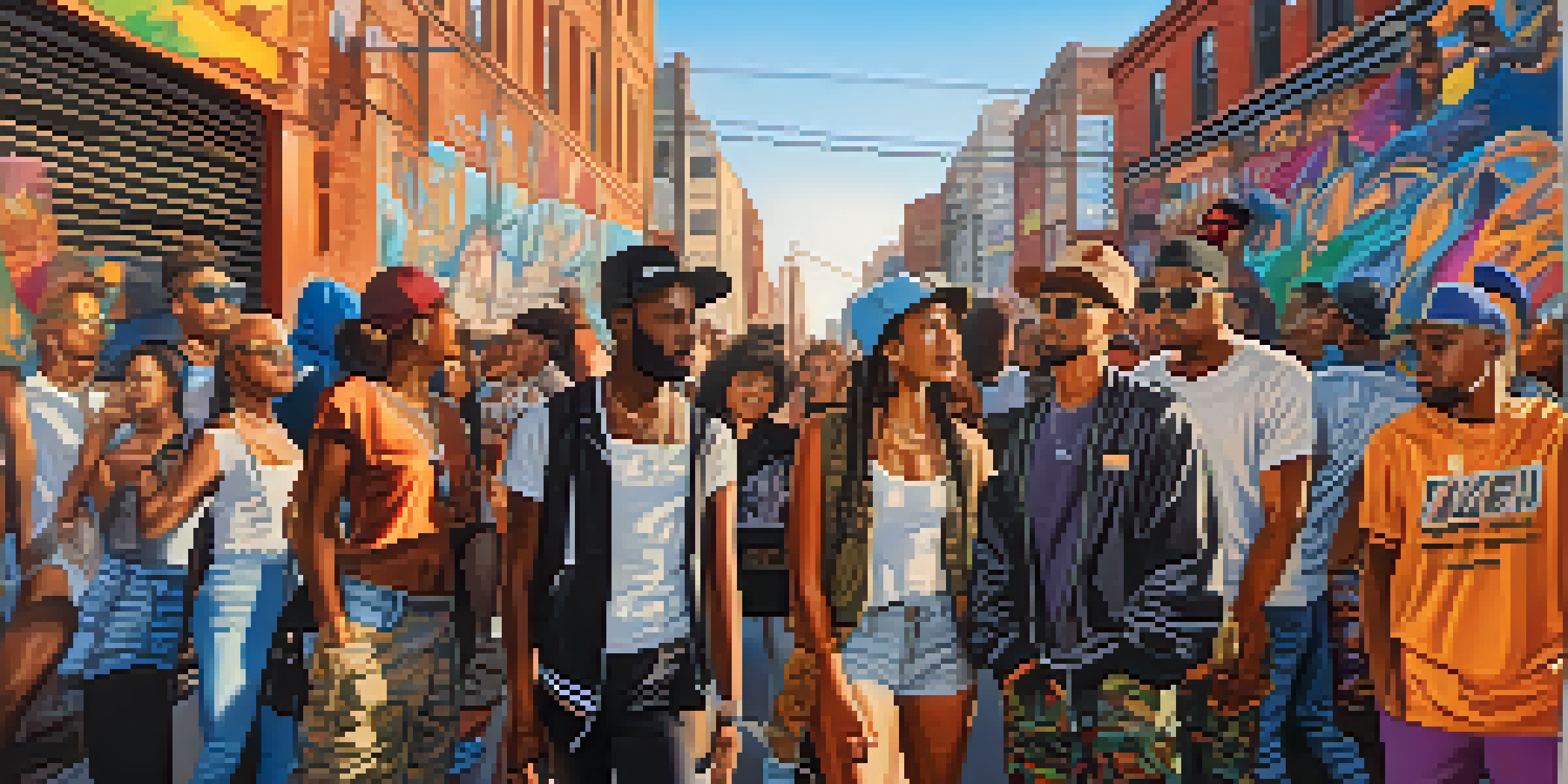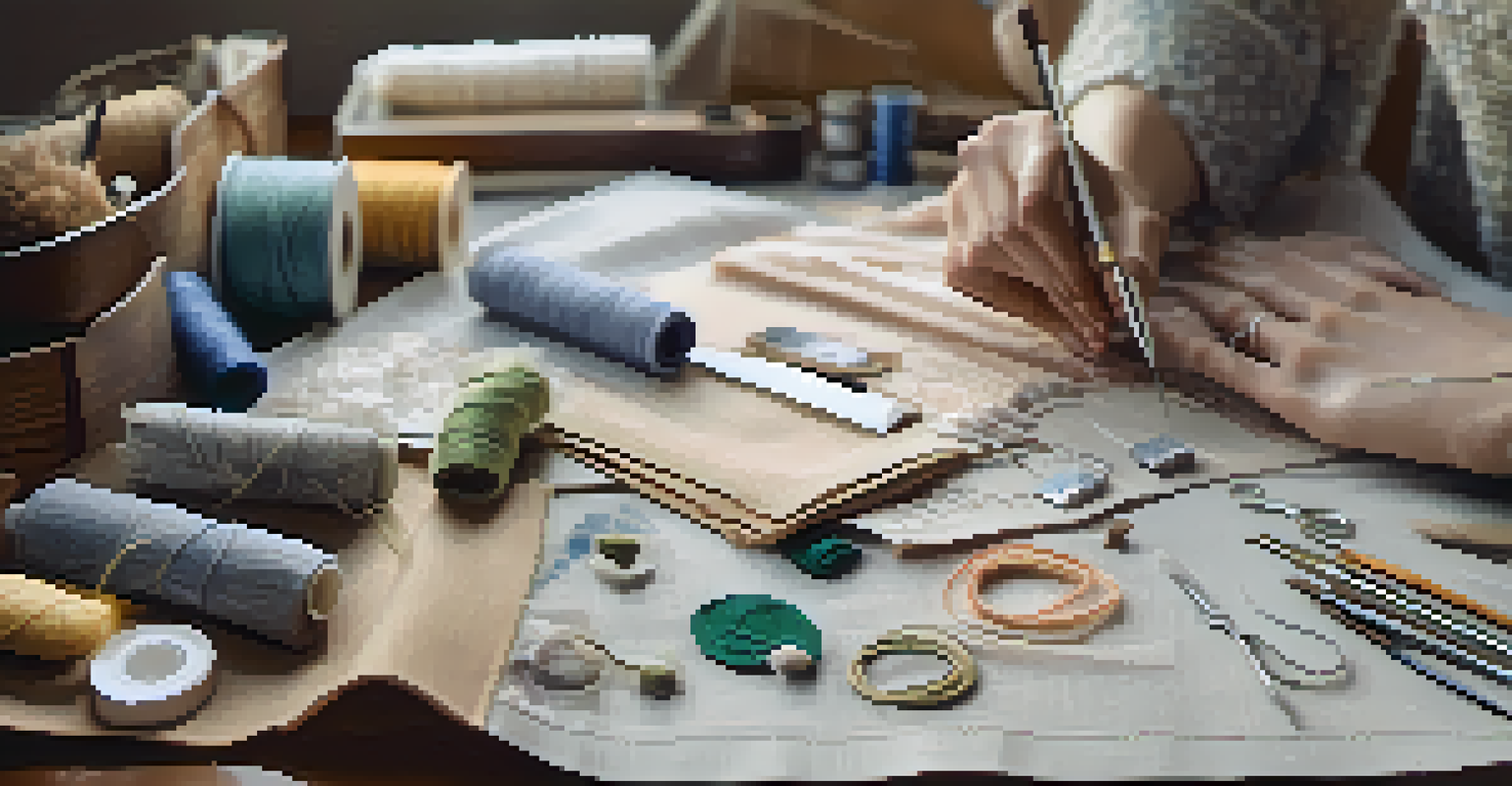How Social Justice Movements Influence Fashion Trends Today

Understanding the Connection Between Fashion and Social Justice
Fashion and social justice have always shared a unique bond, reflecting the values and struggles of society. When movements like Black Lives Matter or climate advocacy gain momentum, they often influence what people choose to wear. This relationship highlights how clothing can serve as a canvas for activism, allowing individuals to express their beliefs and support causes through fashion choices.
Fashion is the armor to survive the reality of everyday life.
For example, during the Women's March in 2017, many participants donned pink 'pussy hats' as a symbol of unity and resistance. This simple accessory quickly became a powerful statement, showcasing how fashion can amplify voices and messages. It also illustrates how trends can emerge from social movements, leading to widespread adoption and recognition.
As we navigate through different eras of activism, it's clear that the interplay between fashion and social justice is not just a fleeting trend. It's a reflection of our collective consciousness, evolving as society changes. This dynamic relationship encourages consumers to think critically about their clothing choices and the messages they convey.
The Rise of Ethical Fashion Influenced by Activism
In recent years, there's been a notable shift towards ethical and sustainable fashion, largely driven by social justice movements. Consumers are increasingly aware of the environmental and social implications of their purchases, prompting brands to adopt more responsible practices. This trend mirrors the growing demand for transparency and accountability in the fashion industry.

Brands like Patagonia have become leaders in this movement, advocating for environmental justice while promoting sustainable practices. Their commitment to using recycled materials and supporting grassroots organizations resonates with consumers who prioritize ethical choices. This approach not only fosters brand loyalty but also inspires other companies to follow suit.
Fashion as a Tool for Activism
Clothing serves as a powerful medium for individuals to express their beliefs and support social justice causes.
The ethical fashion movement underscores the idea that clothing can be a force for good. By choosing to support brands that align with social justice values, consumers can contribute to a larger change. This shift is not merely about aesthetics; it’s about making conscious choices that reflect our beliefs and impact the world positively.
How Social Media Amplifies Fashion Activism
Social media has revolutionized how social justice movements engage with the public, particularly in the fashion realm. Platforms like Instagram and TikTok allow activists to showcase their messages through fashion, reaching vast audiences in real-time. This digital landscape has become a vital space for promoting awareness and inspiring change.
Clothing is a form of self-expression; there are hints about who you are in what you wear.
For instance, hashtags like #FashionForFuture and #SustainableFashion have gained traction, uniting individuals around common causes. Influencers and everyday users alike share their sustainable fashion choices, encouraging others to consider the impact of their wardrobe. This grassroots approach has empowered many to join the movement, making activism more accessible.
Moreover, social media enables brands to connect directly with consumers, fostering a sense of community. When a brand takes a stand on social issues, it can create a loyal following among those who share similar values. This interaction not only shapes trends but also reinforces the idea that fashion can be an instrument of change.
Streetwear: A Reflection of Social Movements
Streetwear has emerged as a dominant force in fashion, deeply intertwined with social justice themes. Originating from urban culture, this style often serves as a platform for expressing resistance and identity. Designers and brands frequently incorporate messages of empowerment and activism into their collections, making a bold statement.
Take, for instance, brands like Off-White and Supreme, which have utilized their platforms to address social issues. Their collections often feature graphics and slogans that challenge societal norms, encouraging conversations about race, inequality, and justice. This fusion of art and activism resonates with a younger audience eager to make a statement.
Fashion as a Tool for Activism
Clothing serves as a powerful canvas for expressing beliefs and supporting social justice movements.
Streetwear's ability to marry fashion with social messages exemplifies its role in contemporary culture. As individuals don these influential pieces, they not only showcase their style but also align themselves with movements that matter to them. In this way, streetwear becomes more than just clothing; it transforms into a symbol of solidarity and change.
Fashion Icons Leading the Charge for Social Justice
Many fashion icons have harnessed their platforms to advocate for social justice, influencing trends with their activism. Celebrities like Billie Eilish and Emma Watson use their visibility to highlight issues such as body positivity and gender equality. Their impact extends beyond fashion, inspiring fans to engage with important social causes.
For example, Eilish's choice to wear oversized clothing challenges traditional beauty standards, promoting a message of self-acceptance. Similarly, Watson's work with the HeForShe campaign emphasizes the importance of gender equality, encouraging men and women alike to join the fight. These figures illustrate how fashion can become a vehicle for meaningful dialogue.
By aligning their personal style with their beliefs, these icons set trends that resonate on a deeper level. They remind us that fashion is not just about aesthetics; it's also about making statements and supporting movements. This intersection of celebrity and activism fosters a culture where fashion becomes a powerful tool for change.
The Role of Inclusivity in Modern Fashion Trends
Inclusivity has become a cornerstone of contemporary fashion, driven by social justice movements advocating for representation. As consumers demand more diverse and equitable representation in fashion, brands are responding by expanding their size ranges and showcasing models of varied backgrounds. This shift emphasizes the importance of inclusivity in shaping modern trends.
For instance, brands like Savage X Fenty have redefined the beauty standards in the lingerie industry by featuring models of all shapes, sizes, and ethnicities. This approach not only celebrates diversity but also challenges the traditional notions of beauty that have long dominated the fashion landscape. As a result, more consumers feel seen and represented in the fashion narratives.
Rise of Ethical Fashion Choices
Consumers increasingly demand ethical practices, prompting brands to prioritize sustainability and social responsibility.
The push for inclusivity is not just a trend; it's a movement that seeks to empower individuals to embrace their uniqueness. By fostering an environment where everyone feels welcome, the fashion industry can create a more vibrant and authentic culture. This change reflects a broader societal shift towards acceptance and understanding, making fashion a truly inclusive space.
The Future of Fashion: Continuing the Legacy of Activism
As we look to the future, the influence of social justice movements on fashion is likely to persist and grow. The ongoing dialogue around sustainability, diversity, and ethical practices will continue to shape consumer preferences and industry standards. This evolution signifies a promising shift towards a more responsible fashion landscape.
Emerging designers are already incorporating these values into their work, crafting collections that prioritize social consciousness. This new wave of talent not only embraces innovation but also recognizes the power of fashion as a tool for advocacy. By championing causes that resonate with their audience, these designers contribute to a legacy of activism within the industry.

Ultimately, the future of fashion lies in its ability to adapt and respond to the needs of society. As movements for social justice evolve, so too will the trends and styles that define our culture. This ongoing relationship between fashion and activism ensures that clothing will remain a powerful medium for expressing beliefs and driving change.